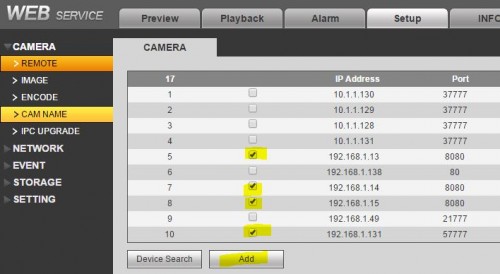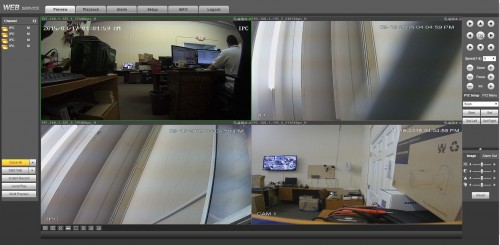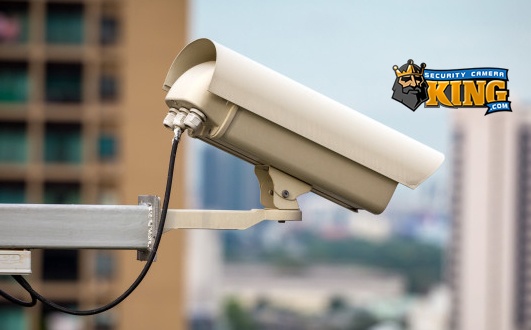For years, many customers have asked me what is the best way to to connect an IP camera to an NVR (Network Video Recorder). In this article, I will describe what I think are the best settings you should have in your NVR and IP cameras.
One thing I will recommend to you is to investigate how your network is laid out and have some knowledge of how many computers are connected to your network. This way, it will prevent any IP conflict when configuring the IP camera and the NVR security recorder. By default, all of our recorders will be set with a static 192.168.1.108 and the majority of the IP cameras will be DHCP.
The easiest way to figure what to do at this point is to connect the recorder to the power supply that comes with the unit and then connect an Ethernet cable from your router to the Ethernet port of the NVR. After the unit turns On you will then need to go to the network settings of the NVR. Of course, you need to be connected to a monitor to see these settings.
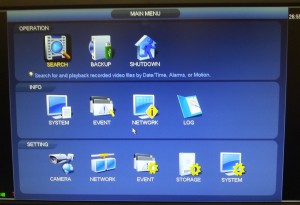
Most of our NVRs will have a new interface, the “blue interface”, and the menus will be spread out a bit different than the previous version. At this point you will notice that there are 3 parts of this window menu: The top is operation, mid is info, and bottom is setting. Go to network and the following page will display:
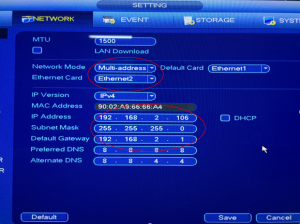
Depending on the type of NVR you have, some will have additional settings, but overall the steps are the same. We will be focusing on getting an IP address for the NVR. Click on DHCP, apply and save. You will be kicked out of that menu and in a few seconds your NVR will contact the router to get an available IP address. Go back to the network settings to see what IP address you received. Normally what I will do is to set the IP address to a digit higher than what the NVR was assigned. This way I will avoid any IP conflicts in the network. Certain router’s DHCP settings will start from 192.168.1.100 all the way to 192.168.1.254 and it also depends on the network scheme and who configured the router initially. Assuming that the router’s scheme is within the numbers above I will set the NVR with the following IP: 192.168.1.200.
Now that I have that out of the way the next thing to do is configure the IP cameras. In the past, all of our IP cameras used to be configured with this IP address: 192.168.1.108. Many times customers and installers used to connect all the cameras at the same time without considering that it could cause a major problem when trying to assign an IP address to the camera or even to have the cameras show up in the tool finder (Config Tool). Nowadays most of our cameras are configured as DHCP. Therefore, if you have a router in the same network as the NVR, then most likely the camera will get an IP address from the DHCP pool setup in the router as soon as it is connected to the the POE switch that they will be connected to.
Here a snapshot of the config Tool:
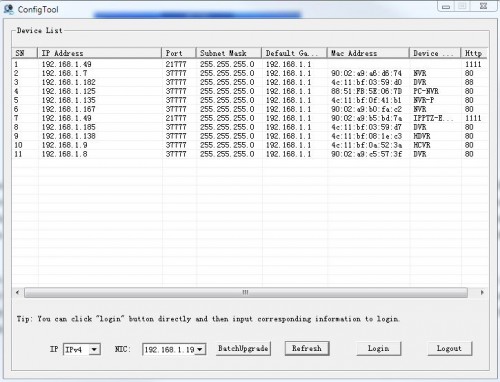
CAMERA CONFIGURATION PROCESS
Open the config tool and it should populate all of the IP addresses that your equipment got assigned from the network.
NOTE: THERE IS NOT A 100% GUARANTEE THAT ALL THE CAMERAS WILL BE DHCP. THEREFORE, IT COULD NOT SHOW ALL OF THE CAMERAS CONNECTED IN THE NETWORK. AT THAT POINT IT WILL BE RECOMMENDED TO CONNECT ONE CAMERA AT THE TIME AND CHANGE EACH IP ADDRESS AS YOU CONNECT EACH CAMERA.
Assuming that each camera showed up in the tool, click on one of the IP addresses and a box will appear asking you for a username and password:
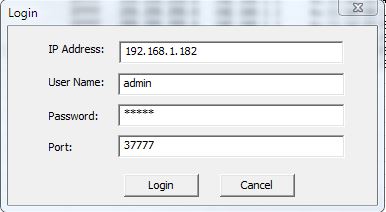
Click on login to access the camera’s IP interface:
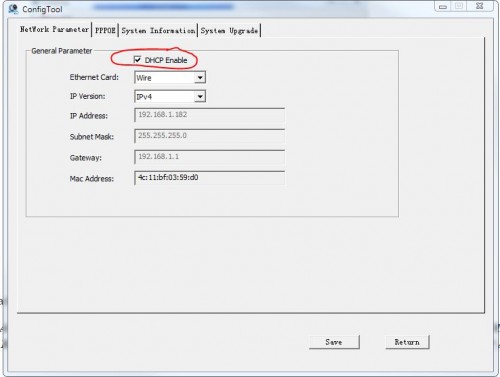
If the camera is configured DHCP most likely it will show like the picture above. Noticed the IP address field along with subnet mask and gateway are gray out. Uncheck the DHCP option marked in red and now you will be able to change the last digit of the camera’s IP address to something different. Like I said before, I will change this camera’s IP address to 192.168.1.220 and click save.
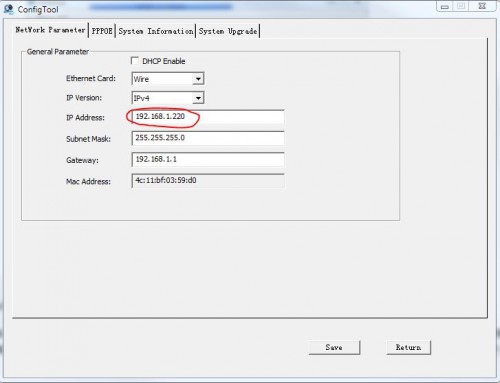
Now that we have assigned an IP address in the camera, it is time to access the camera’s settings and features. To do so, you will need to open Internet Explorer and begin to set up some of the features of the browser. Click on this link https://www.securitycameraking.com/securityinfo/forum/remote-viewing-software/web-service/ to follow step by step of how to setup this feature.
Type the IP Address of the camera on the address bar of your browser to access the web service. Once the web service comes up, input the username and password. The default username and password for our cameras is “admin”. After accessing the camera make sure the ActiveX files are installed. They will be needed to access and configure Video resolutions, Schedule, etc.
On the left side of the camera settings go to conditions to adjust the brightness, contrast, HUE etc. I normally leave these settings alone, and just change them depending on the environment.
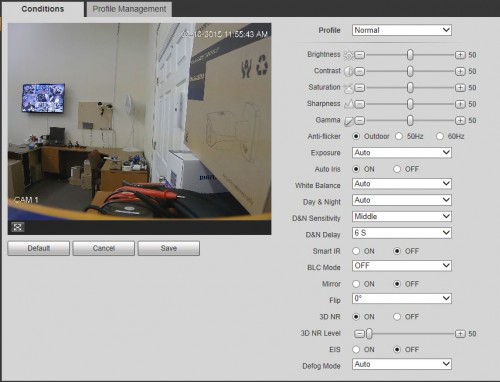
Click on video to configure the resolution of the camera, Frames per second, Encoding, etc. This part of the settings is crucial because it has to do with the recording resolution. Notice that you have two columns: One label is Main Stream and the other is Sub Stream. In a nutshell, this is referring to recording streaming and viewing streaming. The Main Stream settings will affect how the camera sends the image to the NVR over the network, among other things; it will also affect recording quality and how many FPS (Frames per Second) your NVR will be able to use as each camera gets added to each of the NVR Channels.
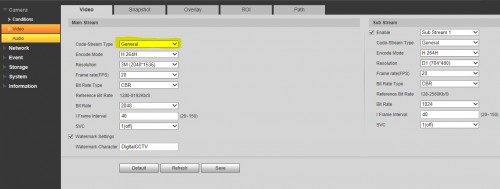
NOTE: DVRs have a maximum amount of FPS (frames per second) that they can handle. In the case of NVRs, the majority of them are restricted to an amount of incoming bandwidth, which it makes certain NVRs to support higher resolutions. Although that is a true statement, I will never have cameras connected to the unit using the maximum bandwidth they can handle, because realistically a network can only handle so much data at one time. For those NVRs with a fixed incoming bandwidth, you will need to divide the advertised speed by the amount of cameras connected to the NVR to realize what bit rate each of the cameras need to be set at. Also, you most consider that the incoming bandwidth is shared also with the sub stream. So, on an NVR that supports 200Mbps for incoming bandwidth you will need to allocate 32 Mbps for the Sub Stream, so at the end you will have 168Mbps available in the Main Stream to stream and record.
Once you have decided how many cameras you will be adding to the NVR, it is important to configure the correct FPS, Bit Rate Type and Bit Rate. For the Bit Rate Type I recommend “CBR” (Constant Bit Rate) instead of “VBR” (Variable Bit Rate), this way the camera will constantly use a predetermine amount of data you set under Bit Rate. The Bit Rate settings will vary depending on what resolution the camera is configured. For a 1080p resolution I will set the Bit Rate to 1024 (1MB) and the FPS to 15. This amount of data is more than enough to stream one camera at 1080p without loosing pixels.
Next we will set the Sub Stream settings. These settings will not affect recording video quality; instead it will affect the way the video performs over a smart phone while using our app TechproSS or TechproSS plus. This is mainly just for viewing purposes and should be set to D1 at 7 FPS or 10 FPS. The Bit Rate type is fine if we use CBR, and the Bit Rate can be set anywhere between 250 Mbps to 320Mbps. Also make sure the Enable option for this Stream is checked, otherwise you will not be able to view any kind of video while viewing the cameras over the phone or NVR local Interface. Under “Code-Stream Type”, click on the Drop Down and choose Motion. Noticed that the Encode Mode and Resolution are now gray out, and this means that you can only change the FPS and Bit Rate to affect how motion events occurs. These settings are ideal when recording based on Motion only, so you can have the Main Stream at a less intense setting and the NVR will record at a higher FPS and resolution when Motion happens due to these settings. Click Save when done.
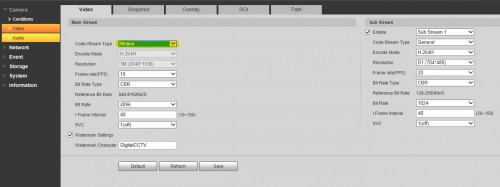
Proceed to “Event > Video Detect”. In here we can enable the motion detection feature of the camera. Also, we can adjust the “Anti-Dither”. This acts like a delay to prevent false motion events. The higher the number, the higher the delay the camera will react to motion events. Right now, I like these settings shown in this picture:
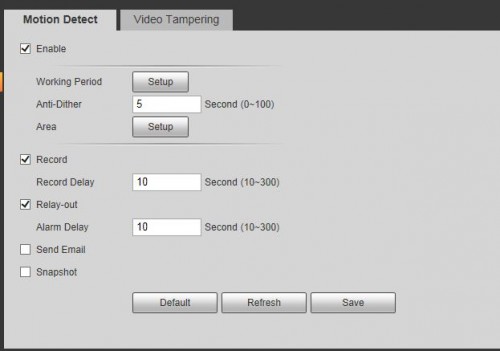
Next option is the Schedule. Click on “Storage > Schedule” and you can set now Motion recording for every day 24/7. Always remember to save your settings.
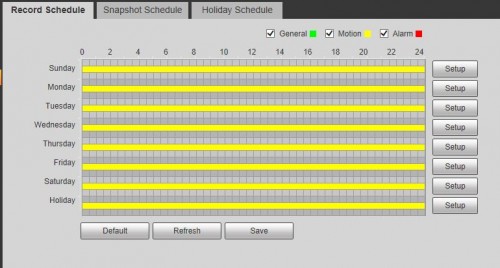
We are almost done configuring the camera. The last thing we need to make sure we have correct is the Time Zone and Date and Time. This is so the info will be displayed correctly in the NVR. You can click on “Sync PC” button to get the Time and Date of your PC instead of doing it manually. DST is another option you could set up if you want the camera to change its time when the time changes occurs. NOTE: I will much rather to get DST configured over using an NTP server, because the NTP server works with the Time Zone of the Camera and the NVR. I have seen that I’m force to change the Time Zone when the time changes. Typically DST occurs the 2nd week of March and the first week of November every year, but is worth give it a try in my opinion. Check the internet for more details about the time changing based on a the upcoming years.
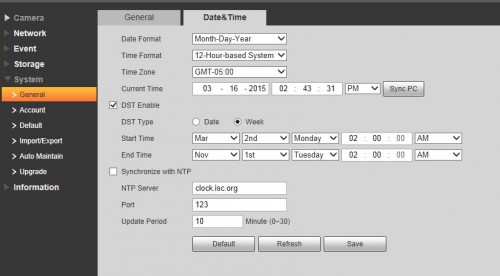
Lastly you could export all of these settings if you have many cameras to apply this to. The file containing the settings of the camera will not change the IP address of the camera so is safe to apply this to the cameras you are configuring.
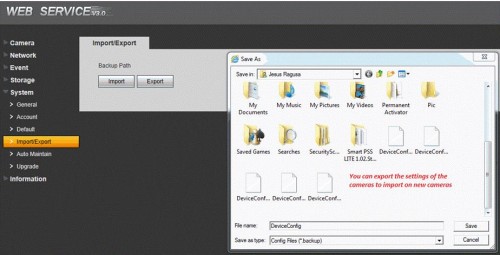
HOW TO ADD THE CAMERAS TO THE NVR
Now for the last step after all of the cameras and NVR are configured, we will need to add the cameras to the channels of the NVR. To me the easiest way to do this is from a PC accessing the NVR over the network. Open Internet Explorer and begin typing the Internal IP address of the NVR.
Go to Setup> Remote and you can click on device search. At this point the NVR will search the entire network and will display the devices for you to select them and add them to the NVR.
At this point, after we add the cameras they should show up in the NVR web interface and the device list below:
Here is how the cameras will look in the web interface:
I hope this article will help you understand how this process works.



